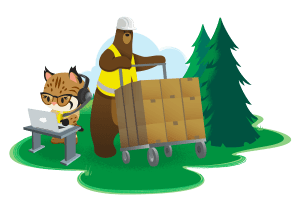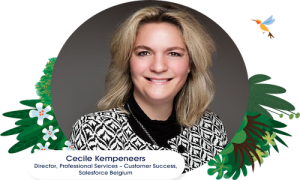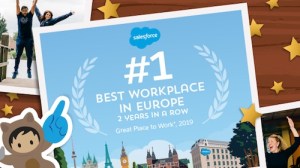How to Foster a Productive Company Culture in 7 Steps



This Salesforce post reveals 7 powerful tips for fostering a company culture that will increase productivity and employee satisfaction.

Ana Lara
A productive company culture is the driving force behind any successful business. But as small businesses grow, their company culture also needs to evolve to meet the needs of a growing team.
While a small team can thrive in a DIY start-up culture, you need to lay the groundwork for a productive company culture when your headcount increases significantly. Back in 1999, Salesforce was still a startup in a small San Francisco apartment. But over the next few years, the company scaled rapidly to over 400 employees in multiple locations. Our productive company culture allowed us to maintain a healthy, thriving and productive culture while scaling at speed.
This blog post reveals some unique insights from Salesforce’s own story from start-up to enterprise that might also serve as a guide for small and medium-sized business owners.
1. Set clear company values to foster a culture of productivity
Here, at Salesforce, trust is a central value. This trust also encompasses our productivity culture, meaning we trust our employees to hit their targets.
We also believe that this culture of trust organically extends to our customers. Our aim is to ensure we offer the most trusted infrastructure in the industry as well as inspire trust in our customer relationships through transparent communication.
Our other core values include customer success, innovation and equality.
- Customer success is absolutely critical for ensuring our customers are happy, so it’s not just a goal, it’s a company value.
- As a tech company, we are always looking to improve our product and integrate the latest in technological innovation, but we also want to inspire this culture in our employees. Giving employees the space to innovate is the key to success.
- Finally, equality is crucial: as you scale your company, you need to have a culture where everyone is treated as equal – and that isn’t limited to the recruitment process. Employees from all walks of life should feel happy in every work environment and championing equality is a great place to start.
2. Share the bigger picture with aligned company goals and KPIs
As your company grows, it can be tricky to keep everyone on the same page. But this is the goal to strive for. At Salesforce, we accomplish this by sharing the bigger picture: every employee should have access to the company’s goals at all times. By being transparent, you inspire trust and team collaboration.
In order to share the bigger picture with all of our employees, we use the V2MOM process. V2MOM is an acronym for vision, values, methods, obstacles, and metrics.
- This model helps ensure that our business plan is fully transparent to each employee and that their role in it is clear. All employees in the company have their own personal V2MOM that feeds into the company V2MOM, and all V2MOMs are visible to everyone else in the company in our V2MOM mobile app.
- V2MOM empowers employees to take ownership of key initiatives.
- V2MOM allows for seamless stakeholder alignment.
- V2MOMs form the basis for regular discussions with managers and make it easy to adjust and track progress in real time. It’s a highly effective strategy that drives alignment, and prioritisation, and allows you to view productivity indicators at a glance.
Check out our Trailhead trail on the V2MOM process to learn more.
3. Stay productive by avoiding silos and focusing on collaboration in teams
To keep your team productive, you need to equip them with the right tools.
- We use our innovative CRM across all our departments to get a 360 view of our customers. Every employee has the right data at the right time.
- Using team collaboration tools like Quip and Chatter, we keep our teams organised and seamlessly integrated with all departments.
- Our powerful analytics and reporting capabilities also allow managers to see key KPIs and reports at a glance, and keep teams on track to hit their targets. These tools also can help track and foster employee productivity.
4. Have a culture of open and constant feedback
High-performing teams always have one thing in common: great communication. If your team encounters issues, they need to feel they can communicate them without their competency being called into question.
So adding a constant feedback loop to your company culture allows project managers and department heads to remove any obstacles to work efficiency; for example, if the workload is too high. Your team needs to feel that they have somewhere to go when they need help.
Our efforts to create an open culture is one of the factors that has made Salesforce one of the best places to work in the UK and has allowed us to grow from a start-up in 1999 to 400+ employees worldwide in 2003 and 30,000+ employees now in 2020.
5. Foster a culture of learning
At Salesforce, we have developed an interactive learning platform: Trailhead that allows employees and customers to get the most out of their experience with us. It enables employees to continually develop or refresh their skills, but also helps new employees with their onboarding. Ultimately, high-performing employees always want to learn something new, so a culture of learning can inspire them and boost their overall satisfaction and engagement.
6. Increase employee satisfaction to boost work efficiency
Happy employees are more productive. At Salesforce, we work really hard to boost employee engagement and try to offer perks that are not just financially beneficial but actually mean something to our staff.
One great example is our commitment to giving back (see next tip). We also reimburse professional development expenses for those who want to further their education and offer extra health benefits. We hold ourselves to a high standard and review our packages every year to ensure our team gets the best.
7. Inspire your employees to volunteer
Salesforce has committed to donating 1 percent of its product, equity and employee hours to philanthropic causes. This 1-1-1 philanthropic model adds up to seven days of paid time off a year for each employee that they use to give back to the causes they care about. It’s always inspiring to see the diverse array of projects they contribute to. It’s a fantastic way to establish trust and loyalty with your employees while giving something back at the same time.
How to measure productivity in the workplace
When looking to foster a productive company culture in the workplace, measuring productivity and setting KPIs can play a critical role in keeping employees engaged and motivated. Understanding how to measure productivity in the workplace is crucial for measuring your team’s success.
Measuring productivity and having productivity indicators in place can help you to refine and evolve your company culture as your business scales. Regular feedback sessions such as QBRs (quarterly business reviews) and the use of the V2MOM model mentioned above are all highly effective ways to foster a culture of productivity.
Download our new e-book to learn how CRM can help you reach your SME’s business goals with more agility, flexibility, and streamlined communication.





















